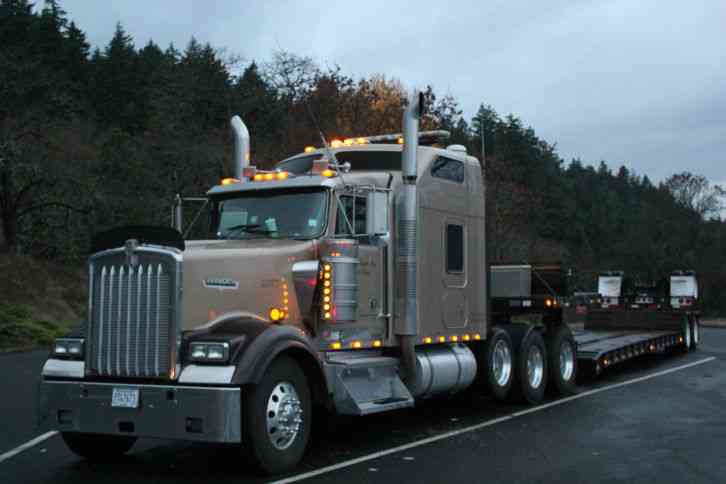Used 4 Axle Heavy Haul Trucks For Sale: Your Comprehensive Guide to Powering the Oversized Load pickup.truckstrend.com
In the demanding world of logistics, where standard semi-trucks simply won’t suffice, a specialized breed of vehicle steps in: the heavy haul truck. When the cargo is oversized, overweight, or both, a 4-axle heavy haul truck becomes an indispensable asset. These robust machines are engineered to move the largest and most challenging loads, from colossal construction equipment and massive wind turbine components to complex industrial machinery.
For businesses looking to enter or expand into the lucrative heavy haul sector, or for owner-operators seeking to upgrade their capabilities, the prospect of acquiring a new heavy haul truck can be daunting due to the significant capital investment. This is where the market for Used 4 Axle Heavy Haul Trucks For Sale truly shines. Buying used offers a cost-effective pathway to acquiring a high-capacity workhorse, providing immediate operational readiness and a quicker return on investment. This comprehensive guide will navigate the intricacies of purchasing a used 4-axle heavy haul truck, equipping you with the knowledge to make an informed and strategic decision.
Used 4 Axle Heavy Haul Trucks For Sale: Your Comprehensive Guide to Powering the Oversized Load
Understanding the 4-Axle Configuration in Heavy Haul
The "4-axle" designation typically refers to the prime mover (the truck itself) having four axles for weight distribution and traction, often in an 8×4 or sometimes a 6×4 configuration with a liftable pusher or tag axle. This setup is crucial for several reasons:
- Increased Gross Vehicle Weight Rating (GVWR): More axles mean the truck can legally support and distribute a much heavier portion of the combined vehicle weight, reducing axle load on bridges and roads.
- Enhanced Traction: Multiple drive axles (e.g., in an 8×4 configuration with two steer axles and two drive axles) provide superior grip, essential for navigating challenging terrains and initiating heavy loads.
- Improved Stability: The broader footprint and additional axles contribute to better stability, particularly when hauling top-heavy or dynamically shifting loads.
- Regulatory Compliance: Many jurisdictions have strict bridge formula laws and axle weight limits. A 4-axle truck allows for compliance when combined with multi-axle trailers, facilitating the legal transport of superloads.

Unlike standard semi-tractors, 4-axle heavy haul trucks are built with reinforced frames, more robust suspensions, higher horsepower engines, and specialized transmissions designed to handle immense torque and sustained heavy pulling.
Why Choose a Used 4-Axle Heavy Haul Truck?
The decision to opt for a used heavy haul truck is often driven by compelling economic and practical advantages:

- Significant Cost Savings: The primary benefit is the substantial reduction in purchase price compared to a brand-new unit. Heavy haul trucks are highly specialized and expensive when new, making depreciation a major factor. Buying used allows you to avoid the steepest part of this depreciation curve.
- Immediate Availability: New trucks often come with long lead times due to manufacturing schedules and customization. A used truck can be acquired and put into service much faster, allowing you to seize immediate business opportunities.
- Proven Performance and Reliability: A used truck has a track record. With proper due diligence, you can assess its past performance, maintenance history, and identify any recurring issues. Many well-maintained used trucks offer years of reliable service.
- Access to Specialized Features: The used market often features trucks with specific heavy haul specifications that might be difficult or expensive to order custom as new, such as specialized wet kits, heavy-duty fifth wheels, or particular engine configurations.
- Lower Insurance Premiums: Generally, insurance costs for used vehicles are lower than for new ones, contributing to reduced operating expenses.

Key Considerations When Buying a Used 4-Axle Heavy Haul Truck
Purchasing a used heavy haul truck requires meticulous attention to detail. Here are the critical factors to evaluate:
- Engine & Powertrain:
- Horsepower & Torque: Look for engines typically in the 500-600+ HP range with high torque ratings (e.g., 1850-2050 lb-ft or more). Popular choices include Cummins X15, Caterpillar C15 (older models), Detroit DD15/DD16, and Volvo D16.
- Transmission: Heavy haul often benefits from manual transmissions (13, 18-speed) for precise gear control, though automated manual transmissions (AMTs) are gaining popularity for their efficiency. Ensure the transmission is rated for heavy loads.
- Rear Axle Ratios: Lower (higher numerically) rear axle ratios are preferred for heavy hauling as they provide more pulling power, albeit at lower top speeds.
- Wet Kit/PTO: Essential for operating hydraulic trailers. Verify its condition and capacity.
- Frame & Chassis Integrity: The backbone of a heavy haul truck. Inspect the frame rails thoroughly for cracks, bends, previous repairs, or severe corrosion. A compromised frame can be a deal-breaker.
- Suspension System:
- Types: Heavy haul trucks often feature robust air-ride suspensions for comfort and load protection, or heavy-duty spring suspensions for ultimate durability.
- Condition: Check airbags, shocks, leaf springs, hangers, and bushings for wear or damage.
- Braking System: Ensure all components (compressor, air lines, drums/rotors, pads, ABS system) are in excellent working order. Heavy loads demand impeccable braking power.
- Fifth Wheel: Verify its capacity, condition, and whether it’s a sliding fifth wheel (for weight distribution adjustments) or a fixed type. Look for excessive wear on the plate and locking jaws.
- Tires & Wheels: Inspect tire tread depth, uneven wear patterns (indicating alignment issues), and wheel condition (cracks, damage). Tires are a significant operating expense.
- Maintenance History & Records: This is paramount. Detailed service records provide insights into the truck’s past life, indicating diligent maintenance, major repairs, and potential recurring issues. Look for evidence of regular oil changes, filter replacements, and component overhauls.
- Mileage & Engine Hours: While high mileage isn’t necessarily a red flag if maintenance is thorough, lower mileage/hours can indicate less wear. However, for heavy haul, engine hours are often a better indicator of true workload than mileage.
- Regulatory Compliance: Confirm the truck meets current emissions standards (e.g., EPA 2010, GHG14/17) for your operating region.
Where to Find Used 4-Axle Heavy Haul Trucks
The market for used heavy haul trucks is specialized but accessible:
- Specialized Heavy Equipment Dealerships: These dealers often have dedicated heavy haul divisions with experienced sales staff and technicians. They can offer warranties, financing, and pre-inspected units.
- Online Marketplaces: Websites like TruckPaper.com, CommercialTruckTrader.com, MyLittleSalesman.com, and IronPlanet.com (for auctions) are excellent resources for browsing a wide selection.
- Auction Houses: Ritchie Bros. Auctioneers, Alex Lyon & Son, and other industrial auctioneers frequently feature heavy haul trucks. Auctions can offer good deals but require quick decisions and thorough pre-inspection.
- Fleet Sales: Larger heavy haul companies occasionally sell off portions of their fleets as they upgrade. This can be a source of well-maintained, high-spec trucks.
- Brokers: Experienced brokers specialize in connecting buyers with sellers of niche equipment like heavy haul trucks.
The Inspection Process: A Buyer’s Guide
Never purchase a used heavy haul truck without a comprehensive inspection.
- Pre-Purchase Inspection (PPI) by an Independent Mechanic: This is non-negotiable. Hire a qualified, independent heavy truck mechanic specializing in diesel engines and heavy equipment. They will perform a thorough diagnostic scan, fluid analysis, engine compression test, and detailed physical inspection.
- Your Own Visual Inspection:
- Exterior: Look for body damage, rust, alignment of panels, and condition of lights.
- Interior: Check gauges, controls, seat condition, and overall cleanliness. A well-maintained interior often indicates a driver who cared for the truck.
- Engine Bay: Look for leaks, frayed wires, unusual modifications, and general cleanliness.
- Undercarriage: Inspect drive shafts, U-joints, differentials, and any signs of impact damage.
- Test Drive: Take the truck for a substantial test drive, ideally with some weight if possible. Pay attention to:
- Engine performance (power, acceleration, smoke).
- Transmission shifts (smoothness, responsiveness, unusual noises).
- Braking effectiveness (pulling, fading, noise).
- Steering (play, responsiveness).
- Suspension (bumps, rattles).
- Listen for unusual noises from the engine, transmission, or axles.
- Paperwork Verification: Confirm the VIN on the title matches the truck, check for liens, and verify service records.
Challenges and Solutions in Used Heavy Haul Truck Acquisition
- Challenge: Hidden Problems: The biggest risk with used equipment.
- Solution: Mitigate with a mandatory, comprehensive PPI by a trusted, independent mechanic.
- Challenge: Financing: Specialized equipment requires specialized financing.
- Solution: Seek lenders who specialize in heavy equipment and commercial vehicle financing. Be prepared with a solid business plan and financial history.
- Challenge: Transportation: Getting the truck to your location.
- Solution: Factor in transportation costs. Many sellers can arrange delivery, or you may need to hire a specialized transport service.
- Challenge: Customization & Upgrades: The truck may not be 100% spec’d to your exact needs.
- Solution: Budget for potential upgrades like a specific headache rack, additional fuel tanks, or minor mechanical adjustments post-purchase.
- Challenge: Parts Availability: For older or less common models, parts can be an issue.
- Solution: Research parts availability for the specific make and model before purchasing. Stick to well-known brands where possible.
Practical Advice and Actionable Insights
- Define Your Needs First: Before you even start looking, clearly define the maximum weight and dimensions of the loads you intend to haul. This will dictate the minimum specs you need.
- Budget Beyond the Purchase Price: Account for taxes, registration, insurance, immediate maintenance/repairs, potential upgrades, and transportation costs.
- Network: Talk to other heavy haul operators. Their experiences and recommendations can be invaluable.
- Don’t Rush: The right truck is worth waiting for. Patience and thoroughness will save you headaches and money in the long run.
Estimated Price Table for Used 4-Axle Heavy Haul Trucks For Sale
Prices for used 4-axle heavy haul trucks vary significantly based on make, model, year, engine, transmission, mileage, condition, and specific heavy-haul features. The table below provides estimated ranges for illustrative purposes only. Always conduct a thorough inspection and market analysis before making a purchase.
| Make/Model (Examples) | Year Range | Condition | Mileage Range (Miles) | Key Features (Typical) | Estimated Price Range (USD) |
|---|---|---|---|---|---|
| Peterbilt 379/389 | 2005-2015 | Good | 500,000 – 900,000 | Cummins/Cat, 18-spd, Wet Kit, Double Frame, Heavy Axles | $55,000 – $120,000+ |
| Kenworth W900/T800 | 2008-2018 | Good | 400,000 – 800,000 | Cummins/PACCAR, 18-spd, Wet Kit, Double Frame, High HP | $60,000 – $150,000+ |
| Freightliner Coronado/Cascadia (Heavy Spec) | 2012-2020 | Very Good | 300,000 – 700,000 | Detroit DD15/DD16, AMT/18-spd, PTO, Liftable Axle, Heavy GVWR | $70,000 – $160,000+ |
| Volvo VNX/VNL (Heavy Spec) | 2014-2021 | Excellent | 250,000 – 600,000 | Volvo D16, I-Shift AMT, Wet Kit, Reinforced Chassis | $80,000 – $180,000+ |
| Mack Anthem/Titan (Heavy Spec) | 2015-2022 | Excellent | 200,000 – 550,000 | Mack MP8/MP10, mDrive AMT, Wet Kit, Multiple Axles | $90,000 – $200,000+ |
| Older/High Mileage | Pre-2005 | Fair | 900,000+ | Varies greatly, may need significant work | $20,000 – $50,000 |
Note: Prices are highly variable and subject to market conditions, region, specific features, and the results of a detailed inspection. This table is a general guide and not a guarantee of actual prices.
Frequently Asked Questions (FAQ)
Q1: What is the typical lifespan of a used 4-axle heavy haul truck?
A1: With proper maintenance, a heavy haul truck can last well over 1,000,000 miles or 20,000 engine hours. The key is consistent preventive maintenance and addressing issues promptly. Many units are rebuilt or repowered, extending their usable life significantly.
Q2: What kind of maintenance can I expect after purchasing a used heavy haul truck?
A2: Immediately after purchase, budget for a full fluid and filter change (engine, transmission, differentials), a comprehensive chassis lube, and a thorough inspection of brakes and tires. Be prepared for ongoing preventive maintenance (PMs) every 10,000-15,000 miles, as well as potential major component replacements (e.g., turbo, injectors, clutch) depending on the truck’s age and history.
Q3: Do I need special licenses to operate these trucks?
A3: Yes, operating a heavy haul truck requires a Class A Commercial Driver’s License (CDL) with appropriate endorsements (e.g., air brakes, combination vehicle). Depending on the Gross Combined Weight Rating (GCWR) and the specific load, additional permits and escorts may be required by state and federal regulations.
Q4: Can I finance a used heavy haul truck?
A4: Absolutely. Many financial institutions specialize in commercial truck and heavy equipment financing. Lenders will typically look at your credit history, business plan, and the truck’s age and condition. Be prepared for higher interest rates and potentially shorter loan terms than for new equipment.
Q5: How do I determine the right GVWR/GCWR for my needs?
A5: Your required GVWR (Gross Vehicle Weight Rating) and GCWR (Gross Combined Weight Rating) are determined by the maximum weight of the loads you anticipate hauling, including the weight of your truck, trailer, and cargo. It’s crucial to calculate this accurately and ensure the truck’s specifications, including axle ratings and frame strength, meet or exceed these requirements for safety and legal compliance.
Q6: What are common red flags when inspecting a used heavy haul truck?
A6: Common red flags include: significant oil leaks, excessive smoke from the exhaust (especially blue or white smoke), mismatched tires or uneven tire wear, visible frame cracks or poorly repaired welds, non-functional gauges or warning lights, excessive play in the steering, grinding noises during shifting, and lack of maintenance records. Any of these should prompt further investigation or negotiation.
Conclusion
The market for Used 4 Axle Heavy Haul Trucks For Sale presents a unique opportunity for businesses and owner-operators to acquire the robust capabilities needed for specialized transportation without the prohibitive costs of a new acquisition. By understanding the specific demands of heavy haul, diligently assessing the truck’s condition, leveraging expert inspections, and carefully navigating the purchasing process, you can make a strategic investment that will empower your operations for years to come. With thorough due diligence, a used 4-axle heavy haul truck can be a powerful, reliable, and cost-effective workhorse, driving success in the most challenging corners of the logistics industry.



